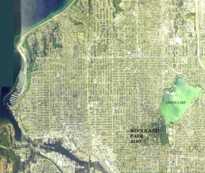ASA/CAA '05 Meeting, Vancouver, BC



Pacific Northwest Vowels: A Seattle Neighborhood Dialect Study
|
Jennifer Ingle merywen@u.washington.edu
Richard Wright Alicia Beckford Wassink Department of Linguistics P.O. Box 354340 University of Washington Seattle, WA 98195-4340
Popular version of paper 2pSC14
|
 |
 |
As early as 1889, when the American Dialect Society was founded, researchers have
been concerned with the description and classification of English dialects in the
United States. Through the combined efforts of sociolinguistic and acoustical phonetic
research, great strides have been made in developing our understanding of what it means
to “speak American.”
The Northwest, which may be considered to include any combination of Washington, Oregon,
Idaho, parts of northern California, western Montana and Wyoming, as well as British Columbia
and Alberta in Canada, is one of the fastest growing metropolitan regions in North America
and is home to a lively assortment of cultures and a diverse geography. Despite this, dialect
studies have paid this region relatively little attention, lumping everything west of the Rocky
Mountains into a broad “Western” dialect which, according to leading dialect researcher
William Labov, “has developed a characteristic but not unique phonology .”
Presented here is a small-scale site study of the acoustic model of vowel production of fourteen
speakers from the Ballard neighborhood in Seattle,
Washington which, combined with larger representative samples based on survey methodology, will
contribute to a more detailed picture of variety within the “Western” dialect.
Participants were recorded in two styles of speech: individually reading a word list targeting
the 15 American vowels, and engaged in casual conversation with an interlocutor matched in age,
gender, and social mobility. Dyads were either friends or family of one another. The goal was
to create a compatible data set for comparison with current acoustic studies, while imposing careful
controls on sociolinguistic variables. Demographic questionnaires were also completed by the
speakers to provide information for future analysis in the Social Network Theory framework.
Discussions of the Western dialect necessarily include mention of the “low-back merger”,
the merging of the vowels
found in the words cot and caught. That is, while in some dialects these
two words sound different, in those dialects where the merger occurs, they sound exactly the same.
The present study confirms this finding within the population of speakers from Ballard.
This man from Michigan makes the distinction between stopped
and small. The difference is lost, however,
between the following pairs of words spoken by people from Ballard:
hot hawed hot hawedIn what has been described as the “Canadian Shift,” this merger is thought to trigger changes in other vowels, as it leaves a “gap” in the vowel space. One such change, which might be expected to occur in the Ballard speakers, is the retraction of the vowel in bad to sound more like bod. Here are two examples, the first from Canadian English:
odd ought odd ought
I usually smoke about half a pack a day...And from California English:
thatFindings were inconclusive. Male speakers tended to retract slightly, while females showed some raising.
A second property associated with the Western dialect is fronting of the vowel found in words such as rude or who’d to become more like ri-ood or hi-ood. This shows up, for example, in California. Click on the following word to hear uw-fronting:
moveThe Ballard speakers did not demonstrate this. For example:
hoot root“Canadian Raising” is the name which has been given to the pattern where the first part of the diphthong found in words such as height and out are raised, when they occur before a voiceless consonant. (Diphthongs are vowels which begin with one vowel sound and gradually shift to another, as in point, pout, pipe. In a voiceless consonant, the vocal cords are not vibrating to produce sound during the consonant, for example: p,t,k,f.) Examples of Canadian English contrasting pairs, raised and unraised diphthongs:
hoot who’d
five fifeAgain, although some speakers showed some inclination for raising before voiceless consonants, the data do not support this feature for the dialect of these speakers.
loud stout
In addition to vowel quality, we sometimes vary phonation type, or voicing quality. It is not uncommon for American females to use what is called “breathy” voicing, and males to use “creaky” voicing. In the first type, the vowel is spoken with a sighing or “h-like” quality. The second type may be heard in “hat.”
Women in the Northwest have a tendency to use creaky voicing more. It showed up in the elicitation task, and 6 out of the 8 females used it regularly throughout their conversations.
This is actually like, an apartment building...While it is possible to generally describe how these Ballard speakers pronounce their vowels based on the analysis of the more formal speech used when reading a list of words, there is still important information missing. Is this really how they talk in their daily lives? In the seventies, groundbreaking sociolinguistic research in Norway by Jan-Petter Blom and John Gumperz verified the common-sense notion that there are indeed very different ways we talk in different situations, which are governed by social factors like the formality of our setting, or our relationship with who we are talking to. By considering a variety of speech styles as they occur in different registers, researchers have access to a fuller range of language production. They can elicit, by asking someone to read a script or list of words, sounds like the vowel in look, which is relatively rarely used in casual speech, but by also recording people engaged in more casual conversation in a natural setting, researchers can take into account the variety of ways we may produce each sound when we’re not focusing on deliberate pronunciation.
And, I mean, they broke up...
Here are three examples of the vowel ae, as in hat, in three environments.
I just like, like Ballard, it’s got...With the low-back merger, as mentioned above, Ballard speakers no longer make a distinction between, for example haughty and hottie. One would expect the resulting merged vowel to fall somewhere between the two. This proved to be the case, with a preference for the lower vowel, in the word list data. In the conversational data, we see a rather different pronunciation, something approaching the sound in the word had. It is interesting to note that this is marked as a property of another vowel shift occurring in the Inland North, the “Northern Cities Chain Shift.”
Two and a half hours, and I had to take a three hour nap.
He just kind of waves the Bible, or a flag, or...
I saw it being delivered...Two very different instances of the vowel ey, considered a diphthong in American English, and not in Canadian.
All of her pots, and stuff...
I said, “God it’s a gorgeous day!”
People were honking at her...
Lost all this weight; she was like, five pounds...Much more could be said about this dialect, both about its vowels in neutral phonetic contexts, and about the variety of those vowels produced in casual speech. Not to mention the consonants, like why you find such a pronounced “s” in the Northwest.
I was watchin’ the Braves...
Charles Lindbergh lived his last years in HawaiiThus the speech from this collection of Ballard residents conforms to some, but not all, traits and patterns of change expected within the phonology of the broadly-defined Western Dialect Region to which it is considered to belong.
To hear more Canadian English, visit visit the University of Arizona’s Language Samples Project.
To hear more Californian English, visit Penelope Eckert’s Web Page.
To hear more from other dialects, visit The International Dialects of English Archive.